
PROGRAM NOTES
Shimmering Sounds from Bali: The Gamelan Ensemble of the Indonesian Institute of the Arts
Listen Now
download
Subscribe (itunes)
Subscribe (rss)
help
Program
Shimmering Sounds from Bali:
The Gamelan Ensemble of the Indonesian Institute of the Arts
Professional Ensemble of the Indonesian Institute of the Arts at Denpasar (Institut Seni Indonesia, Denpasar)
Head of Delegation: I Gede Arya Sugiartha
| Song | Track |
|---|---|
Jaya Semara (1964) |
0:00–4:08 |
Kebyar Trompong (1925) |
4:21‒11:42 |
Legong Kuntul |
12:00–26:26 |
Taruna Jaya (ca. 1930) |
26:49–37:05 |
Musicians from Bali: I Gede Arya Sugiartha (gangsa), I Ketut Garwa (kendang), I Nyoman Windha (ugal), I Gusti Putu Sudarta (ceng-ceng), I Made Sujendra (gong), I Made Desi Muliartana (kajar)
Musicians from the United States: I Ketut Gede Asnawa (kendang), I Nyoman Suadin (jegogan), I Made Lesmawan (reong and kantil), I Nyoman Saptanyana (gangsa), I Putu Tangkas Adi Hiranmayena (reong and kantil)
This recording was made live in concert on November 2, 2013, as part of Performing Indonesia: A Conference and Festival of Music, Dance, and Drama. The podcast is made possible through support from the Thaw Charitable Trust. Audio preservation and editing of this recording were supported by funds from the Smithsonian Women’s Committee.
Listen Now
download
Subscribe (itunes)
Subscribe (rss)
help
Notes
Music and Dance with Gamelan Gong Kebyar
The dynamic musical ensemble known as gamelan gong kebyar was developed in the villages of north Bali around 1915. This ensemble, with its heavier and louder xylophones and gong-chimes and its emphasis on fast tempos and dramatic shifts, represented a radical departure from the softer and more delicate sound of the traditional temple gamelan known as gamelan pelegongan. The most influential composer and teacher of the new kebyar style was Gede Manik of Jagaraga village in Kabupaten Buleleng. Even a revered teacher of the older pelegongan tradition, I Lotri of Kutra village, adopted the new style while expanding its repertoire with subtler elements from the old tradition.
Jahya Semara
This music was composed by I Wayan Beratha in 1964 while the composer was performing for a cultural mission to the New York World’s Fair. The composition, in the virtuosic kebyar style, was crafted as a short tour of the entire gamelan ensemble, demonstrating to outsiders the roles and abilities of each part of the orchestra.
Kebyar Trompong
This music and its accompanying choreography are early examples of the kebyar repertoire, composed in 1925 by I Nyoman Maria. Now considered a classical item in the kebyar repertoire, it features a single male dancer who performs an extended solo on the trompong gong-chime. The dancer for this performance was I Putu Dedik Sutyana.
Legong Kuntul
This is a traditional work with music in the elegant and restrained pelegongan style that predates the kebyar innovations. The dancers portray two storks playfully feeding in the rice fields. Legong refers to a genre of classical dance believed to have first developed in the palaces of east Bali around the sixteenth century. Typically performed by young women, legong dancers traditionally began their training at four to six years of age. The dancers for this performance were Kadek Ayu Era Pinatih and A A Istri Inten Pradnyandari.
Taruna Jaya
The music for this dance was composed around 1930 by Pan Wandres and I Gede Manik and was derived from the culture of north Bali (Buleleng). The dance is one of the most energetic and vibrant works in the kebyar tradition. Typically danced by a young woman, the choreography depicts an impetuous young man, whose emotional behavior entices the hearts of women. The dancer for this performance was Ni Wayan Sumantari.
Musicians from Bali: I Gede Arya Sugiartha (gangsa), I Ketut Garwa (kendang), I Nyoman Windha (ugal), I Gusti Putu Sudarta (ceng-ceng), I Made Sujendra (gong), I Made Desi Muliartana (kajar)
Musicians from the United States: I Ketut Gede Asnawa (kendang), I Nyoman Suadin (jegogan), I Made Lesmawan (reong and kantil), I Nyoman Saptanyana (gangsa), I Putu Tangkas Adi Hiranmayena (reong and kantil)
Balinese Gamelan and Its Music
Bali is host to numerous types of gamelan made of bamboo, iron, or bronze and ranging in size from duets to ensembles of fifty or more musicians. Ancient ensembles that accompany Balinese Hindu ceremonies coexist alongside contemporary experimental ensembles and hybrid orchestras of gamelan and Western instruments.
Four kinds of ensembles performed at the four-day event, Performing Indonesia: A Conference and Festival of Music, Dance, and Drama (October 31‒November 3, 2013). Gamelan Lila Muni (from the Eastman Conservatory of Music) and the musicians of the Indonesian Institute of the Arts (ISI) in Denpasar performed the gamelan gong kebyar, a large five-tone bronze ensemble that emerged in north Bali around 1915. This ensemble, an evolution of older gamelan gong and gamelan semar pelegongan orchestras, took Bali by storm in the first half of the twentieth century. Its dynamic and virtuosic dance and musical style remains the most ubiquitous gamelan on the island.
The gamelan angklung (played by the Bucknell University Gamelan) is a much older four-tone bronze orchestra that is traditionally associated with cremation ceremonies and temple processions, but it has absorbed much influence from the gamelan gong kebyar over the past century. The gamelan semar pegulingan (played by Gamelan Pandan Arum from Los Angeles) is a rare form of seven-tone gamelan that is typically associated with instrumental works historically performed in court and temple settings. These ensembles, their tuning, and their repertoire are often unique to specific regions. For example, Pandan Arum’s ensemble is modeled on the renowned and highly distinct form associated with Kamasan.
The more contemporary gamelan semara dana (played by Gamelan Raga Kusuma from Richmond, Virginia, and by Gamelan Dharma Swara from New York City) was invented by the composer and gong-smith Wayan Beratha in 1986. It combines the orchestration of the gong kebyar with the seven-tone range of the semar pegulingan. Although it was intended as a practical “all-in-one” ensemble to facilitate dance-drama accompaniment, composers soon began creating new and experimental works that exploit the expanded possibilities offered by this new kind of Balinese gamelan.
— Andy McGraw, University of Richmond
Listen Now
download
Subscribe (itunes)
Subscribe (rss)
help
Performers
Professional Ensemble of the Indonesian Institute of the Arts at Denpasar
(Institut Seni Indonesia, Denpasar)
Head of Delegation: I Gede Arya Sugiartha
Musicians from Bali
I Gede Arya Sugiartha (gangsa)
I Ketut Garwa (kendang)
I Nyoman Windha (ugal)
I Gusti Putu Sudarta (ceng-ceng)
I Made Sujendra (gong)
I Made Desi Muliartana (kajar)
Musicians from the United States
I Ketut Gede Asnawa (kendang)
I Nyoman Suadin (jegogan)
I Made Lesmawan (reong and kantil)
I Nyoman Saptanyana (gangsa)
I Putu Tangkas Adi Hiranmayena (reong and kantil)
Dancers from Bali
I Putu Dedik Sutyana
Kadek Ayu Era Pinatih
A A Istri Inten Pradnyandari
Ni Wayan Sumantari
Listen Now
download
Subscribe (itunes)
Subscribe (rss)
help
Related Images
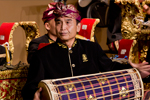
The Balinese gamelan in this concert was led by I Ketut Garwa, who signals the tempo and entrances from the double-headed drum (kendang). This gamelan featured six musicians visiting from Bali and five Balinese musicians currently teaching in the United States.
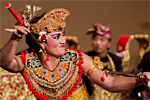
Opening the concert was the trompong kebyar dance. I Nyoman Maria created its music and choreography in 1925. The name reflects the fact that the dancer (here, I Putu Dedik Sutyana) also plays the trompong, a row of gong-chimes.
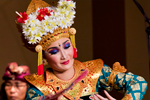
The music for legong kuntul (third on this recording) is a traditional piece in the elegant and restrained pelegongan style, which predates the innovations of the kebyar style. The dancers portray two storks playfully feeding in the rice fields. Legong refers to a genre of classical dance believed to have been first developed in the palaces of east Bali around the sixteenth century. The dancers for this performance were Kadek Ayu Era Pinatih and A A Istri Inten Pradnyandari.
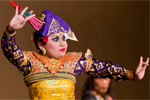
Around 1930 Pan Wandres and I Gede Manik composed the music and choreography for this dance, which is derived from the culture of north Bali (Buleleng). The dance is one of the most energetic and vibrant works in the kebyar tradition. Typically performed by a young woman, the choreography depicts an impetuous young man, whose emotional behavior entices the hearts of women. The dancer for this performance was Ni Wayan Sumantari.

Thousands of people attended the four-day event Performing Indonesia: A Conference and Festival of Music, Dance, and Drama, held October 31 to November 3, 2013, at the Freer and Sackler Galleries.
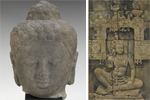
Indonesia was long a destination along the maritime Silk Route. Buddhism arrived in Indonesia by the seventh century with the Srivijaya dynasty; construction of the Buddhist monument of Borobudur occurred in the eighth century during the Shailendra period. The monument includes images of the Buddha, such as the sculpture on the left, as well as murals, captured in the painting on the right.
Left: Head of the Buddha. Indonesia, 8th century. Volcanic stone (andesite). Transfer from the National Museum of Natural History, FSC-S-16
Right, detail: Seated Buddha, by Joseph Lindon Smith (1863‒1950). Oil on canvas; late 19th–mid-20th century. Gift of Charles Lang Freer, F1912.17
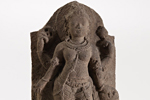
Hinduism arrived in Indonesia from India by the seventh century. This sculpture of the goddess Durga was created in Java in the ninth century, when the Medang dynasty supported Hindu architecture and practice. With the arrival of Islam, many Hindus migrated east to Bali, where a unique Hindu-Balinese religion thrives to this day.
Durga Slaying the Buffalo-Titan. Indonesia, Java, 9th century. Stone. Gift of Charles Lang Freer, F1914.54
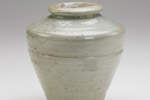
Recently recovered from a 1690 shipwreck, this Chinese jar provides evidence of maritime trade between China and Indonesia. Similar Chinese ceramics still play important roles in Balinese rituals. Other indications of cultural exchange are the Chinese lion dance, which became the barong dance of Bali, and the barong landung dance that commemorates the marriage of a Balinese king and a Chinese princess in the eighth century.
Jar. China, Ming or Qing dynasty, late 16th‒18th century. Porcelain with pale blue transparent glaze. Gift of Osborne and Gratia Hauge, and Victor and Takako Hauge, S2005.51
Listen Now
download
Subscribe (itunes)
Subscribe (rss)
help
The Credits
This podcast was coordinated by Michael Wilpers, public programs manager. It was made possible through support from the Thaw Charitable Trust. Audio preservation and editing of this recording were supported by funds from the Smithsonian Women’s Committee.
Performing Indonesia: A Conference and Festival of Music, Dance, and Drama was a joint presentation of the Embassy of the Republic of Indonesia and the Freer and Sackler Galleries, Smithsonian Institution. It was made possible with support from the Ministry of Education and Culture, Republic of Indonesia.
Thanks to the Smithsonian Audio Visual Department for audio recording, SuMo Productions for audio editing, Hutomo Wicasksono for photography, Andy McGraw for assistance with the notes, Nancy Eickel for text editing, Torie Castiello Ketcham for web design, and especially the artists for permission to present this performance as a podcast.
Podcast Series
Concerts
Storytelling
Lectures
Subscribe to this Series
 RSS
RSS iTunes
iTunes
About Podcasts
About podcasting and how to get started
![]() Tell us what you think
Tell us what you think
Radio Asia
Explore music from all across Asia with Radio Asia, a stream of complete tracks from the collections of Smithsonian Global Sound
Most Recent Podcasts
Musicians from Marlboro IMusic of Toru Takemitsu and Tan Dun: Ralph Van Raat, piano
The Legacy of Yatsuhashi
The Traveler’s Ear: Scenes from Music
Western Music in Meiji Japan: Gilles Vonsattel, piano
Western Music in Meiji Japan
The Art of Afghan Music
Painting with Music: Bell Yung, qin
Sounds from Arabia
Tarek Yamani Trio